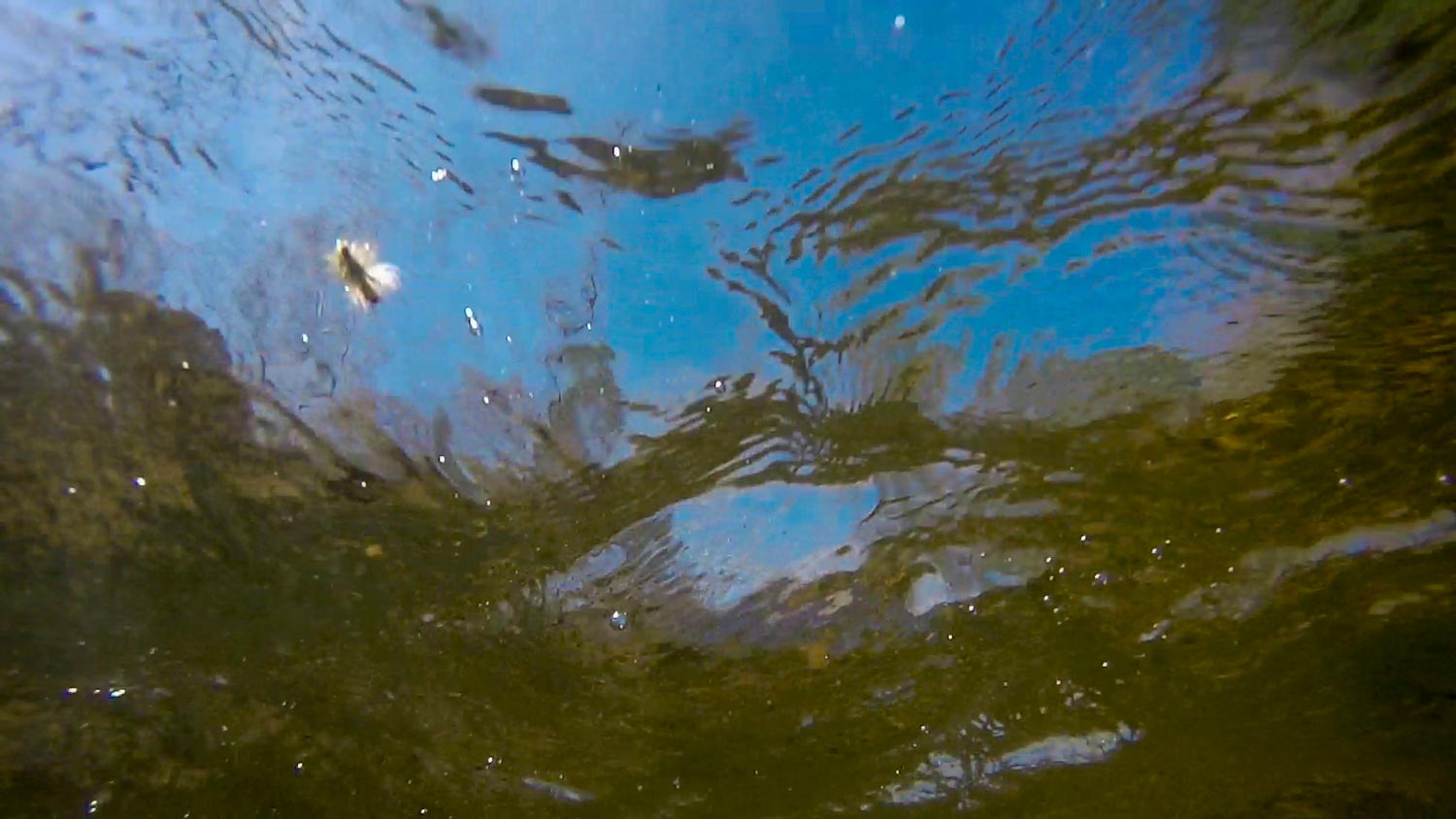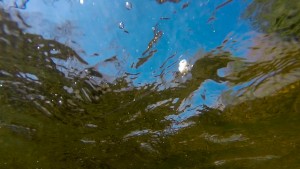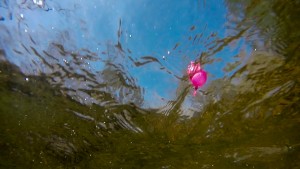By Louis Cahill
Light affects what fish see and how they eat.
I am teaching a young man to fly fish. We have fished well past sundown. There is only a band of warm red along the horizon giving way to a glowing blue sky. A bright moon and stars just beginning to show themselves. Forty feet away the surface of the water dimples and rings in rhythm as trout rise the the evening hatch. My student is frustrated.
“I don’t think they like this fly. Let’s change it.”
“It’s too dark to tie on another,” I tell him, “let’s try this one a little longer. Maybe a few feet longer cast.” I know this is the right fly. He just isn’t reaching the fish.
“I think it’s too dark. They can’t see it.”
“They can see it.”
“How? It’s totally dark. I can’t see it.”
I resist my smart ass nature. I don’t say, “Well they can sure as hell see the naturals.” Instead I tell him, “Look up. Can you see those swallows? That’s what the fish sees. Mayflies, like swallows flying above them.”
This is a simple idea, but one fly anglers don’t often think about. The fish looks at your fly from a different point of view. An almost exact opposite point of view than ours. The world looks a whole lot different from below. Light, and the where it’s coming from, play a huge roll in how you choose and present your fly.
Trout are always looking up.
Even when they are eating nymphs they look for food which is at their level in the water column or higher. Not all species feed in this way. Bonefish or carp for example feed on the bottom. Other species like tarpon look up for their food. The roll which point of view plays in their eating habits, and in your presentation, will vary from species to species. Let’s look at a couple of examples.
If you read the article, “What Does The Trout See,” you know that trout have very acute color vision when the light is bright. That doesn’t always mean that fly color is crucial in full sun. Let’s say it’s mid day and the sun is high in the sky. When fish look up at a dry fly, they are looking right into the sun. Not only is this uncomfortable for them, it seriously limiters their vision.
A fly floating on the surface with the sun directly above will appear as a silhouette. A tiny pattern in a precise color may get little attention. A larger, more pronounced silhouette may get some attention where precise imitation fails. In the morning or afternoon when the sun is lower in the sky, and lights up the dubbed body and hackles of your fly, you had better have your size and color just right.
Let’s say you’re bonefishing.
That sounds nice, let’s say it again! You’re bonefishing! And it’s an overcast day. A fly with a little more flash will make your fly look more alive. It will shimmer in the soft overcast light. In full sun a fly with a lot of flash might look like a kids toy covered in flashing lights. Bonefish may run from it.
Light affects more than fly selection.
It affects your presentation too. Let’s talk about tarpon fishing. Say you find a laid up tarpon and she’s facing into the sun. Her ability to see a fly is greatly diminished. You will need to put the fly pretty close for her to see it. Luckily, the glare of the sun will also help subdue the splash of the fly landing. If you are in that same scenario, except this time the the fish is facing away from the sun, she will have a great view. You had better lead her a lot more and land that fly softly.
Let’s get back to the trout stream for a minute.
And let’s say we’re fishing nymphs. The lighting may affect more than our choice of fly or how far we lead the fish. It may even affect our choice of indicator. If the sun is high in the sky, a bright pink Thingamabobber might not be the best choice. It’s translucent and it’s curvature focuses the light causing a bright pink point of light. That’s why fish so often eat them. This bright pink spot floating above may distract fish from your fly or even spook them. Better to go with yarn or wool.
New Zealand Indicator (left) Thingamabobber (right)
On overcast days a white wool indicator is pretty stealthy. Like Johnny says, match the sky. A white or clear Thingamabobber is a good choice too. Don’t get too worked up about it. Fish see stuff floating downstream all the time.
It’s worth taking a moment now and then to look up. Think about how the light affects what the fish see. Hold your fly up against the sky and look at it from the fish’s point of view. After all, it’s what he sees that matters.
Louis Cahill Gink & Gasoline www.ginkandgasoline.com hookups@ginkandgasoline.com Sign Up For Our Weekly Newsletter!



Great stuff- gotta give a nod to Vince Marinaro and his innovative book
In the Ring of the Rise…….
Nice post!
Marinaro, Schenk, Humphreys, and Betters, etc: old school is never irrelivant in fly fishing, because it all builds from antiquity.
Wonderful post and great reply, Rachel! Hope to see you and yours at the Two-Fly.
Thanks Louis,
Any advice on floating line color? I see more and more use of the olive green color but wonder if it makes a difference? thank you.
I think about this issue all the time man! I think if you ask the guys in New Zealand they will advocate being wise with line color. This is just my opinion so anyone feel free to correct me, but I think bottom line is that your waving this thing in the air all over the place and they will probably see that, and even if you don’t ‘line’ a fish, they still will probably see it, I mean they see mono all the way down to 8x! For me, I just try and stick with modest colors, light greens and such
Maybe I’m wrong….
I don’t know….
That’s my rant and I’m sticking to it
What do you think?
Long ago, I dyed a white Wulff fly line with Kelly green Rit, as I’ve done with a number of lines. That time, I left it in the dye bath too long, resulting in a very dark shade, approaching black. I set it aside until a recent trip to New Zealand. I hooked a number of brown trout with it, and found that it was easy to see in daylight, and easy enough in deep dusk! A floating fly line cuts a seam across the surface that the eye picks up readily.
You will enjoy my article on Friday.
Hey Joe,
How about I answer this with an article in the next couple of weeks? Stay tuned. Thanks!
Looking forward to it Thanks!
Pingback: G & G hits keep comingď | A Fly Rod in My Sea Bag
One of my most fun fly fishing experiences was with my buddy and our two Cub Scout kids at a summer camp lake. It was the last night there and we’d pretty much been skunked previously, only one or two to hand.
This last night we fished the inlet area of the lake from after dinner until well past sunset and the kids caught at least a dozen trout each. I think the flies they threw showed as dark silhouetts against the stars of the night sky.
…and another thing!
Your photos, with their dark, olive-green peripheries of their sight windows, where all good fisherpeeps should be, reinforces my preference for dark, olive-green fishing attire…
Well, for that spot at this time of year anyway.
Ha! Good point, dark, olive green would probably not be preferred on the flats in Andros!
Love to hear a more fully fleshed-out discussion of color of fishing attire.
Great insight! For a quick read, your articles never disappoint.
Pingback: Weekly Review |